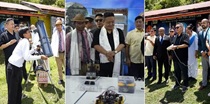15 December, 2025
Pasang Wangchuk Sona ISRO Space Laboratory
Sun 17 Aug, 2025
Context
- The Indian Space Research Organisation (ISRO) in collaboration with the Muskaan Foundation inaugurated a space laboratory in Mechuka, Arunachal Pradesh.
Key Points :
- Inauguration Date: 16 August 2025
- Location: Mechuka Government Higher Secondary School, Shi-Yomi District, Arunachal Pradesh
- Collaboration: ISRO & Muskaan Foundation
- Naming: Pasang Wangchuk Sona ISRO Space Laboratory, in honor of the father of Education Minister Pasang Dorjee Sona
Objectives:
- To provide students with hands-on experience in space science and technology
- To promote STEM education in rural regions
- To encourage scientific curiosity, innovation, and creative thinking
- To bridge the educational gap between urban and rural areas
Key Features:
- Modern Equipment: Tools for satellite technology, rocket science, and space exploration
- Educational Impact: Access to advanced scientific resources in remote Mechuka
- Community Engagement: Active participation of local leaders, teachers, and students
Impact & Significance
- Local Impact: Inspiring students of Mechuka to pursue careers in space science
- National Impact: Reinforcing ISRO’s commitment to promoting scientific education in remote regions of India
- Cultural Significance: Honoring Pasang Wangchuk Sona’s belief in education
Indian Space Research Organisation (ISRO)
- India’s national space agency
- Established: 15 August 1969
- Founder: Dr. Vikram Sarabhai
- Headquarters: Bengaluru, Karnataka
Objectives of ISRO
- Develop indigenous satellite and launch vehicle technology
- Apply space technology for social and economic development
- Support telecommunications, meteorology, telemedicine, and resource surveys
Major Achievements
Chandrayaan Missions:
- Chandrayaan-1 (2008): India’s first lunar mission, discovered water molecules on the Moon’s surface
- Chandrayaan-2 (2019): Partial success; orbiter functional, but Vikram lander failed soft landing
- Chandrayaan-3 (2023): India’s first successful lunar landing; Pragyan rover deployed at the Moon’s south pole
Mars Orbiter Mission (Mangalyaan, 2013):
- India became the first country to reach Mars on its first attempt
Aditya-L1 (2023):
- India’s first solar mission placed at Lagrange Point-1 (L1)
NavIC:
- India’s indigenous regional navigation system, an alternative to GPS
Launch Vehicles (PSLV & GSLV):
- Made India self-reliant in satellite launches on a global scale
Upcoming Missions (2025 & Beyond)
- Gaganyaan: India’s first human space mission; target 2026 to send 3 astronauts into Low Earth Orbit
- Shukrayaan-1: Venus mission, expected around 2026 (initially proposed for 2025)
- Chandrayaan-4: Tentative target for 2028 (not yet officially confirmed)
- NISAR: Joint ISRO-NASA mission for Earth surface monitoring
Major ISRO Centers :
- Vikram Sarabhai Space Centre (VSSC), Thiruvananthapuram: Rocket development
- U.R. Rao Satellite Centre (URSC), Bengaluru: Satellite design & development
- Satish Dhawan Space Centre (SDSC), Sriharikota: Launch pad for rockets & satellites
- Liquid Propulsion Systems Centre (LPSC), Valiamala & Bengaluru: Cryogenic engine development
- National Remote Sensing Centre (NRSC), Hyderabad: Remote sensing data management
- Space Applications Centre (SAC), Ahmedabad: Communication & remote sensing applications
Leadership :
- The Chairman of ISRO is also the Secretary of the Department of Space
- Since January 2025, Dr. V. Narayanan is ISRO’s Chairman, succeeding S. Somanath
Commercial Arm :
- Antrix Corporation Limited is ISRO’s commercial wing, responsible for marketing space products, services, and technology transfer
Major Launch Vehicles :
| Launch Vehicle | Description |
| SLV (Satellite Launch Vehicle) | First Indian launch vehicle (1980s), carried small payloads (~40 kg) |
| ASLV (Augmented SLV) | Upgraded SLV, carried payloads up to 150 kg |
| PSLV (Polar Satellite Launch Vehicle) | ISRO’s most reliable rocket, payloads of 500–1500 kg; used in Chandrayaan-1 & Mangalyaan |
| GSLV (Geosynchronous SLV) | Can launch 2–4 ton payloads to geostationary orbit; equipped with cryogenic engine |
| GSLV Mk III (LVM-3) | ISRO’s heaviest rocket, 8 tons to LEO, 4 tons to GTO; developed for Gaganyaan human mission |
| SSLV (Small Satellite Launch Vehicle) | Latest rocket for small payloads (10–500 kg); low-cost, quick turnaround, flexible launches |


















